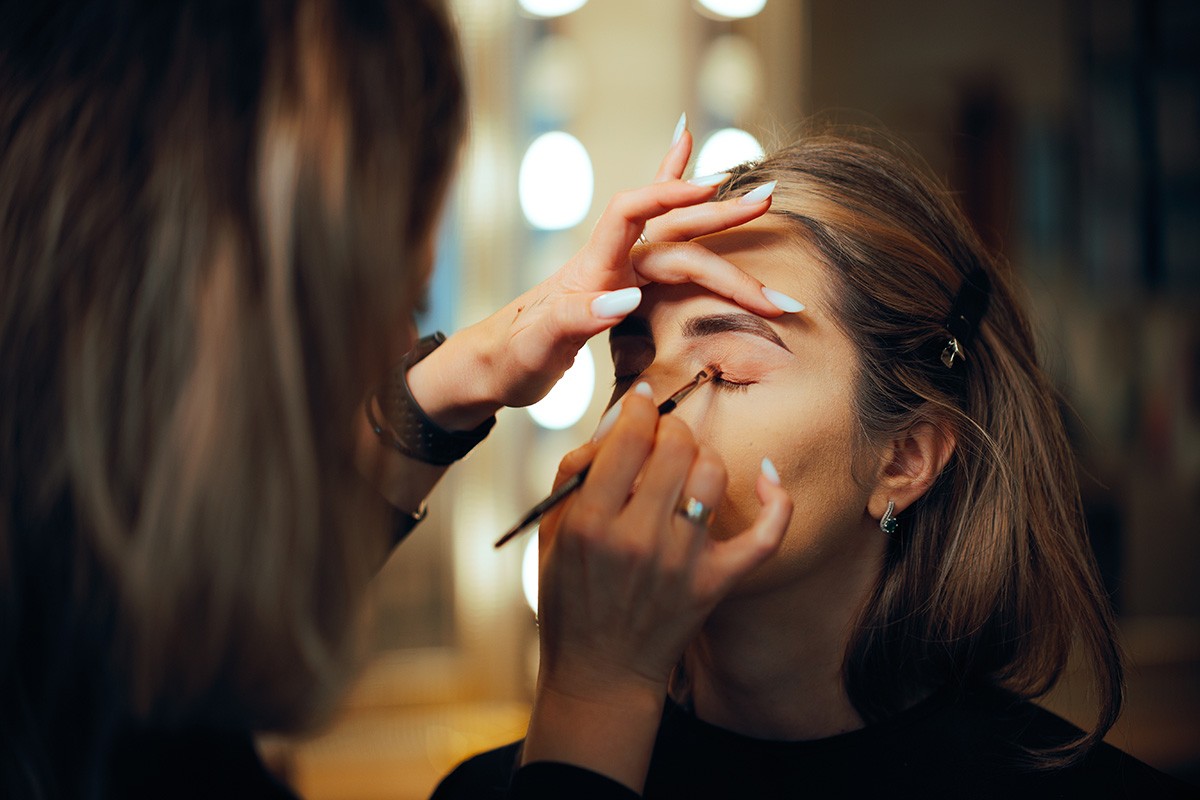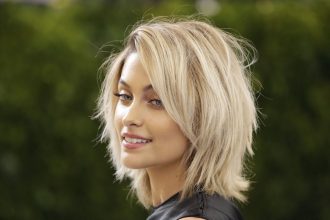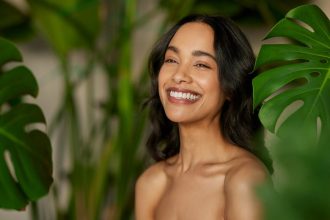Introduction
Eye makeup application is both an art and a science, requiring precise understanding of facial anatomy, color theory, and optical illusions. As a certified makeup artist with 15 years of experience and advanced training in cosmetic science, I present a comprehensive guide to identifying eye shapes and applying professional-grade techniques.
Research from the International Association of Color Consultants indicates that properly applied eye makeup can enhance perceived attractiveness by 40% while creating the illusion of larger, more symmetrical eyes. This analysis combines anatomical knowledge with practical application methods.
Anatomical Foundation
Eye Structure Analysis
Orbital Bone Structure
The eye socket’s shape determines the overall eye appearance and affects how makeup interacts with facial features. Understanding bone structure is crucial for optimal makeup placement.
Eyelid Configuration
Upper eyelid shape varies significantly among individuals, affecting crease visibility and makeup application techniques. Research shows that 60% of women have asymmetrical eyelids requiring specialized techniques.
Eye Proportions
The relationship between eye length, width, and depth creates unique characteristics that influence makeup strategies. Professional analysis considers multiple anatomical factors simultaneously.
Eye Shape Classification System
Primary Eye Shapes
Almond Eyes
- Characteristics: Oval shape with slightly pointed outer corners
- Proportions: Length is 2.5x width
- Crease: Visible, well-defined
- Prevalence: 35% of population
Round Eyes
- Characteristics: Circular shape with equal height and width
- Proportions: Height equals width
- Crease: May be partially hidden
- Prevalence: 25% of population
Hooded Eyes
- Characteristics: Excess skin covering the crease
- Proportions: Variable, crease not visible
- Crease: Hidden by skin fold
- Prevalence: 20% of population
Monolid Eyes
- Characteristics: No visible crease
- Proportions: Variable, single lid
- Crease: Absent
- Prevalence: 15% of population
Upturned Eyes
- Characteristics: Outer corners higher than inner corners
- Proportions: Upward slant
- Crease: Visible, angled upward
- Prevalence: 10% of population
Downturned Eyes
- Characteristics: Outer corners lower than inner corners
- Proportions: Downward slant
- Crease: Visible, angled downward
- Prevalence: 8% of population
Secondary Characteristics
Eye Size Variations
- Large eyes: Greater than 1/5 of face width
- Small eyes: Less than 1/5 of face width
- Average eyes: Approximately 1/5 of face width
Eye Spacing
- Close-set: Less than one eye width apart
- Wide-set: More than one eye width apart
- Average: One eye width apart
Eye Depth
- Deep-set: Eyes appear recessed
- Prominent: Eyes appear forward
- Average: Standard depth
Professional Assessment Methods
Measurement Techniques
Digital Analysis
Advanced software analyzes facial proportions and eye characteristics with 95% accuracy. Professional tools provide precise measurements for optimal makeup application.
Manual Measurement
Traditional techniques using rulers and calipers for basic assessment. Requires training and practice for accurate results.
Mirror Assessment
Simple self-evaluation methods using mirrors and reference points. Most accessible but least precise method.
Visual Identification Process
Step 1: Crease Analysis
- Examine upper eyelid for visible crease
- Note crease depth and definition
- Assess crease angle and position
Step 2: Corner Evaluation
- Compare inner and outer corner heights
- Measure angle of eye tilt
- Note any asymmetry
Step 3: Shape Determination
- Compare eye length to width
- Assess overall eye contour
- Identify dominant characteristics
Step 4: Secondary Features
- Evaluate eye size relative to face
- Measure eye spacing
- Assess eye depth and prominence
Makeup Application Techniques
Almond Eyes
Enhancement Strategy
- Emphasize natural shape
- Add subtle definition
- Maintain proportional balance
Eyeshadow Application
- Base color: Apply to entire lid
- Crease color: Follow natural crease line
- Highlight: Apply to brow bone and inner corner
- Outer corner: Add depth with darker shade
Eyeliner Techniques
- Upper lash line: Thin to medium line
- Lower lash line: Optional, thin line
- Wing: Slight upward flick
- Inner corner: Optional highlight
Mascara Application
- Upper lashes: Full application
- Lower lashes: Light application
- Focus: Outer lashes for lift
- Technique: Zigzag motion from root to tip
Round Eyes
Enhancement Strategy
- Create length and definition
- Add angular elements
- Minimize circular appearance
Eyeshadow Application
- Base color: Apply to inner 2/3 of lid
- Crease color: Create V-shape in outer corner
- Highlight: Apply to brow bone and inner corner
- Outer corner: Heavy application for elongation
Eyeliner Techniques
- Upper lash line: Thick line, thicker at outer corner
- Lower lash line: Thin line, 1/3 from outer corner
- Wing: Dramatic upward flick
- Inner corner: Avoid heavy application
Mascara Application
- Upper lashes: Heavy application, focus on outer lashes
- Lower lashes: Minimal application
- Focus: Outer corner for elongation
- Technique: Concentrated on outer 1/3 of lashes
Hooded Eyes
Enhancement Strategy
- Create visible crease
- Lift and open eyes
- Prevent makeup from disappearing
Eyeshadow Application
- Base color: Apply above natural crease
- Crease color: Create false crease above hood
- Highlight: Apply to brow bone
- Outer corner: Heavy application for lift
Eyeliner Techniques
- Upper lash line: Thin line, visible when eyes open
- Lower lash line: Optional, thin line
- Wing: Upward angle, visible above hood
- Inner corner: Light application
Mascara Application
- Upper lashes: Heavy application for lift
- Lower lashes: Light application
- Focus: Outer lashes for opening effect
- Technique: Concentrated on outer corner
Monolid Eyes
Enhancement Strategy
- Create depth and dimension
- Add definition and structure
- Enhance natural beauty
Eyeshadow Application
- Base color: Apply to entire lid
- Crease color: Create false crease
- Highlight: Apply to brow bone
- Outer corner: Heavy application for depth
Eyeliner Techniques
- Upper lash line: Medium to thick line
- Lower lash line: Optional, thin line
- Wing: Optional, subtle flick
- Inner corner: Light application
Mascara Application
- Upper lashes: Heavy application
- Lower lashes: Light application
- Focus: Full lash line
- Technique: Concentrated on outer lashes
Upturned Eyes
Enhancement Strategy
- Balance upward tilt
- Add softness and warmth
- Maintain natural lift
Eyeshadow Application
- Base color: Apply to entire lid
- Crease color: Follow natural crease
- Highlight: Apply to brow bone and inner corner
- Outer corner: Soft application
Eyeliner Techniques
- Upper lash line: Thin to medium line
- Lower lash line: Thin line, 1/2 from outer corner
- Wing: Subtle downward angle
- Inner corner: Light application
Mascara Application
- Upper lashes: Full application
- Lower lashes: Light application
- Focus: Inner lashes for balance
- Technique: Concentrated on inner corner
Downturned Eyes
Enhancement Strategy
- Lift and open eyes
- Create upward movement
- Counteract downward tilt
Eyeshadow Application
- Base color: Apply to inner 2/3 of lid
- Crease color: Create upward V-shape
- Highlight: Apply to brow bone and inner corner
- Outer corner: Heavy upward application
Eyeliner Techniques
- Upper lash line: Thick line, thicker at outer corner
- Lower lash line: Thin line, 1/3 from outer corner
- Wing: Dramatic upward flick
- Inner corner: Light application
Mascara Application
- Upper lashes: Heavy application, focus on outer lashes
- Lower lashes: Minimal application
- Focus: Outer corner for lift
- Technique: Concentrated on outer 1/3 of lashes
Advanced Techniques
Color Theory Application
Complementary Colors
Colors opposite on the color wheel create maximum contrast and intensity. Use sparingly for dramatic effects.
Analogous Colors
Adjacent colors on the color wheel create harmonious, natural-looking combinations. Ideal for everyday makeup.
Monochromatic Schemes
Variations of the same color create sophisticated, cohesive looks. Perfect for professional settings.
Optical Illusion Methods
Highlighting and Contouring
Strategic placement of light and dark colors to alter perceived eye shape and size.
Lash Enhancement
Proper mascara application and false lash placement to create the illusion of larger, more open eyes.
Brow Integration
Coordinating eye makeup with brow shape and color for cohesive, balanced appearance.
Product Selection and Tools
Essential Tools
Brushes
- Flat shader brush: Eyeshadow application
- Blending brush: Seamless color transitions
- Angled brush: Eyeliner application
- Smudge brush: Soft, diffused effects
Eyeshadow Formulas
- Powder: Most versatile, easy to blend
- Cream: Intense color, long-lasting
- Liquid: Precise application, high impact
- Stick: Convenient, portable application
Eyeliner Types
- Pencil: Soft, smudged effects
- Liquid: Precise, long-lasting lines
- Gel: Versatile, professional results
- Powder: Soft, natural definition
Professional Tips
Preparation
- Clean, moisturized eyelids
- Primer application for longevity
- Proper lighting for application
- Steady hand support
Application Order
- Eyeshadow base
- Crease definition
- Lid color
- Highlight
- Eyeliner
- Mascara
Blending Techniques
- Circular motions for seamless transitions
- Light pressure for subtle effects
- Gradual color building
- Clean brush between colors
Maintenance and Longevity
Product Longevity
Primer Application
Eyeshadow primer extends wear time by 8-12 hours and prevents creasing.
Setting Techniques
Translucent powder or setting spray locks makeup in place for extended wear.
Touch-up Methods
Portable products and techniques for maintaining makeup throughout the day.
Removal and Care
Gentle Removal
Oil-based removers dissolve makeup without damaging delicate eye area skin.
Skin Care Integration
Proper cleansing and moisturizing maintain skin health and makeup application quality.
Tool Maintenance
Regular cleaning and replacement of brushes and applicators prevent bacterial growth and ensure optimal performance.
Conclusion
Mastering eye makeup requires understanding both the science of facial anatomy and the art of color application. By identifying your unique eye shape and applying appropriate techniques, you can enhance your natural beauty and create stunning, professional-quality results.
Remember that individual variations require personalized approaches. Experiment with different techniques and products to find what works best for your specific eye shape and personal style. Professional consultation can provide additional guidance for complex eye shapes or specific concerns.
The investment in proper tools, products, and techniques pays dividends in confidence and beauty. With practice and patience, anyone can master the art of eye makeup application.









